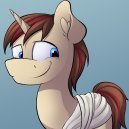mechanics Marks and Coming of Age for Non-Ponies Part 2
Continuing from part 1
Changelings
This differs from hive to hive, and builds off of my own fanon for how changeling operate (Which is inspired in large part by the story A Novel Tale) which I will detail extensively in a later blog post.
Changelings are born or hatched with certain attributes commonly called 'predispositions'. These can vary from subtle to obvious but tend to be similar among those grown in the same cocoon with minor variations. These predispositions often affect what species, gender, or race the changeling is most comfortable portraying, but in no way limits a changeling's ability to disguise as whatever they want. While some changelings feel no particular attachment to any disguise, and change them often, most changeling would say that there is one or a few disguises that they feel a stronger attachment to than others. Those with the privilege of growing up in large, well-established, hives like Troy or Manehatten will have the ability to take special classes before entering the world in an effort to discover these forms that they resonate most closely with, which they call their 'true-selves'. Changelings will work for months or even years perfecting this form, integrating themselves as a new pony to society rather than replacing an existing pony.
As it pertains to marks, given a changeling can choose the mark for themselves, they will often try out a few different ones inside the hive, meditate on options, or attend pony classes as a transfer student as an unmarked pony to experience the sort of things that ponies do to earn their marks, seeking inspiration. Those who do not choose to be ponies will often research similar events for those races and do their best to emulate it. They do this both out of respect for the culture they are entering, and to better complete their chosen persona.
In hive Permutation, there is an additional option. Young changelings may visit the hall of remembrance, and look for candles that have recently burned out, researching the past lives and personas of deceased changelings, then requesting permission to replicate a previous identity to carry on the legacy, often even taking the persona of a changeling who additionally shared their name. This is also an option in hive Sleipnir, but it is less common.
Minotaurs
Minotaur culture is often described as a tightrope between animal and culture, similar to Klingons. From a young age they are taught discipline, how to contain the inner beast, and how to let it out appropriately and constructively. Once they manage to learn self control, usually around the age of 4, they start to see a maze in their dreams. They are encouraged to explore it, but not much importance is given to it until they have finished their first few years of education, at which point they are instructed on how to map and draw the maze in their dreams, revealing the consistencies and the changes over time. Minotaurs believe that this maze guides them through life, warning them of future choices by allowing them to catch glimpses of dead ends or dangers along paths.
This is similar to the Deer's experience with the Path, but often less specific. Each maze is unique, but often similar between those who are closely related or associated. Comparing mazes in a group can help discover the best course of action for a team.
Zebra
Zebra gain marks just like ponies do, though the meaning are often more abstract. Similar to Camels, a zebra's mark is often made of swooping lines and circles, without color. These marks can sometimes match alchemical symbols, indicating a talent for potions, or a type of potions, natural symbols, indicating a connection to nature, among others. Notable among zebra is that their marks are noted to change over time far more often than a pony's would. This is seen as natural and a sign that an aging zebra ought to step down and train an apprentice.
When a mark first appears, the young zebra is brought before an elder, like with Camels or Deer, to have their mark read and better understood.




0 Comments
Recommended Comments
There are no comments to display.
Create an account or sign in to comment
You need to be a member in order to leave a comment
Create an account
Sign up for a new account in our community. It's easy!
Join the herd!Sign in
Already have an account? Sign in here.
Sign In Now